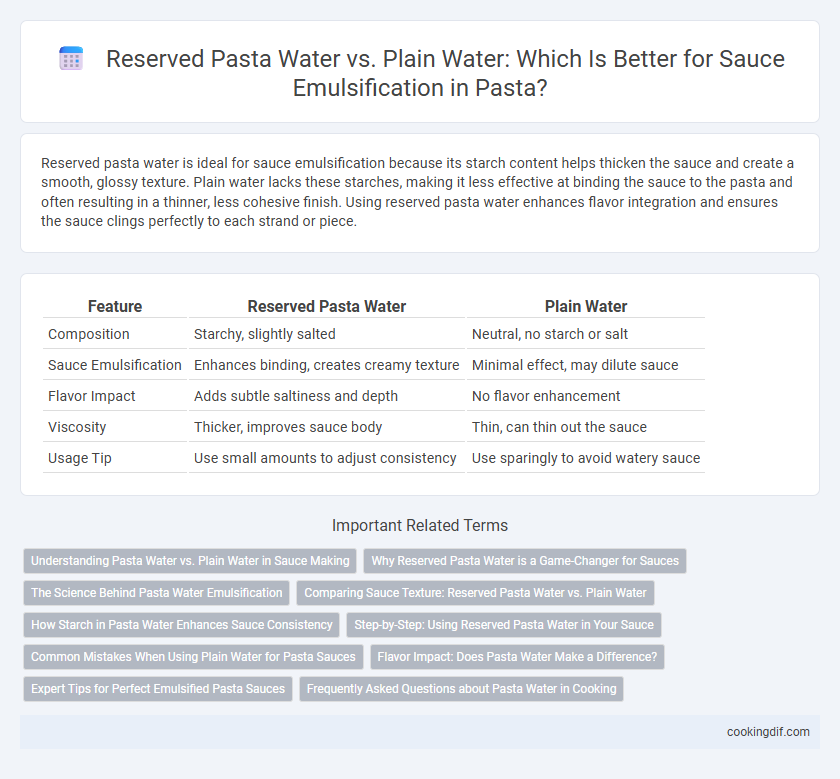Reserved pasta water is ideal for sauce emulsification because its starch content helps thicken the sauce and create a smooth, glossy texture. Plain water lacks these starches, making it less effective at binding the sauce to the pasta and often resulting in a thinner, less cohesive finish. Using reserved pasta water enhances flavor integration and ensures the sauce clings perfectly to each strand or piece.
Table of Comparison
| Feature | Reserved Pasta Water | Plain Water |
|---|---|---|
| Composition | Starchy, slightly salted | Neutral, no starch or salt |
| Sauce Emulsification | Enhances binding, creates creamy texture | Minimal effect, may dilute sauce |
| Flavor Impact | Adds subtle saltiness and depth | No flavor enhancement |
| Viscosity | Thicker, improves sauce body | Thin, can thin out the sauce |
| Usage Tip | Use small amounts to adjust consistency | Use sparingly to avoid watery sauce |
Understanding Pasta Water vs. Plain Water in Sauce Making
Pasta water contains starch released during cooking, which acts as a natural emulsifier for sauces, improving texture and helping sauce adhere better to noodles. Plain water lacks these starches, making it less effective for creating a cohesive, creamy sauce. Utilizing reserved pasta water enhances sauce consistency, flavor integration, and overall mouthfeel in pasta dishes.
Why Reserved Pasta Water is a Game-Changer for Sauces
Reserved pasta water contains starch released from the cooking pasta, which acts as a natural emulsifier to bind and thicken sauces effectively. This starchy water enhances sauce texture, creating a creamy consistency without adding extra fat or flour, unlike plain water. Using reserved pasta water improves flavor absorption and helps sauces cling smoothly to pasta, elevating the overall dish quality.
The Science Behind Pasta Water Emulsification
Reserved pasta water contains starches released from the pasta during cooking, creating a viscous liquid that effectively binds and thickens sauces through emulsification. These starch molecules act as natural emulsifiers, allowing oil and water-based ingredients to combine smoothly, enhancing sauce texture and adherence to pasta. Plain water lacks these starches, making it ineffective for creating the creamy, cohesive consistency achieved with reserved pasta water.
Comparing Sauce Texture: Reserved Pasta Water vs. Plain Water
Reserved pasta water contains starches released during cooking, enhancing sauce emulsification by creating a velvety, cohesive texture compared to plain water, which lacks these starches and may result in a thinner, less stable sauce. The starch in reserved pasta water helps thicken the sauce naturally while binding oil and liquid components, producing a glossy finish and improved mouthfeel. Using plain water can dilute flavors and disrupt emulsification, leading to a sauce that separates more easily and feels less rich.
How Starch in Pasta Water Enhances Sauce Consistency
Starch released from pasta into reserved pasta water acts as a natural thickening agent, creating a silkier and more cohesive sauce consistency. Unlike plain water, pasta water contains amylose and amylopectin molecules that bind with fat and liquid components in the sauce, improving emulsification and texture. Using reserved pasta water transforms sauces by enhancing their body, adhesion to pasta, and overall mouthfeel without diluting flavor.
Step-by-Step: Using Reserved Pasta Water in Your Sauce
Reserve a cup of starchy pasta water before draining to enhance sauce emulsification by binding fat and water molecules. Gradually whisk reserved pasta water into the sauce to achieve a creamy, cohesive texture without thinning the flavor. This technique leverages the water's natural starch content, improving sauce viscosity and helping it cling better to the pasta strands.
Common Mistakes When Using Plain Water for Pasta Sauces
Using plain water for pasta sauce emulsification often results in sauces that lack the desired creaminess and smooth texture because it lacks starch content critical for binding. A common mistake is neglecting the reserve pasta water, which contains essential starches that act as natural thickeners and help sauces cling better to the pasta surface. Without this starchy liquid, sauces can become thin, watery, and fail to achieve the perfect emulsion needed for a rich, cohesive dish.
Flavor Impact: Does Pasta Water Make a Difference?
Reserved pasta water contains starches released during cooking, which enhances sauce emulsification and creates a silkier texture compared to plain water. The starch in pasta water helps bind the sauce to the noodles, intensifying flavor absorption and providing a richer mouthfeel. Using reserved pasta water results in a more cohesive and flavorful sauce that clings better than when using plain water.
Expert Tips for Perfect Emulsified Pasta Sauces
Reserved pasta water contains starch released from the pasta during cooking, making it ideal for emulsifying sauces to achieve a creamy, silky texture. Using plain water lacks these natural emulsifiers, resulting in a thinner, less cohesive sauce. Experts recommend gradually adding reserved pasta water to the sauce off heat while stirring vigorously to create a stable emulsion that clings beautifully to each strand of pasta.
Frequently Asked Questions about Pasta Water in Cooking
Reserved pasta water contains starch released from the pasta during cooking, making it ideal for sauce emulsification as it helps bind the sauce to the pasta and improves texture. Plain water lacks these starches and does not contribute to the sauce's creaminess or adhesion. Frequently asked questions highlight that reserved pasta water should be added gradually to achieve the desired sauce consistency and prevent it from becoming too watery.
Reserved pasta water vs Plain water for sauce emulsification Infographic

 cookingdif.com
cookingdif.com